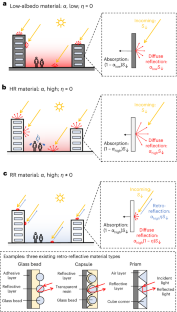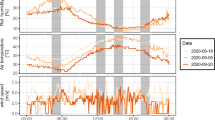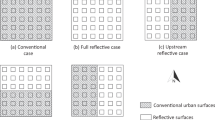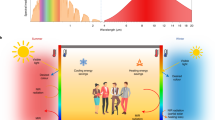Abstract
Extreme heat and its various impacts are a growing threat to cities and their residents, and it is increasingly clear that portfolios of solutions are needed to mitigate the resulting risks. Here we comprehensively evaluate and optimize the application of existing retro-reflective (RR) materials, which reflect incoming solar radiation back to the sky, on urban surfaces to cool them. Using detailed energy budget models, we show that RR walls and pavements decrease urban canyon surface temperatures by up to 20 °C and canyon air temperatures by up to 2.6 °C, outperforming highly reflective surfaces, with a notable improvement in pedestrian thermal comfort (up to 0.55 °C and 153 W m−2 reductions in human skin temperature and net radiative gain, respectively). We then develop optimized RR design guidelines for diverse climatic conditions, latitudes, seasons and urban geometries. On the basis of our analysis, we recommend RR pavements for open, low-rise areas and propose specific RR wall design strategies for compact, high-rise areas.
This is a preview of subscription content, access via your institution
Access options
Subscribe to this journal
Receive 12 digital issues and online access to articles
$119.00 per year
only $9.92 per issue
Buy this article
- Purchase on Springer Link
- Instant access to full article PDF
Prices may be subject to local taxes which are calculated during checkout






Similar content being viewed by others
Data availability
The simulation data for this study are available in the open-access Zenodo repository56 at https://doi.org/10.5281/zenodo.10638146.
Code availability
The core MATLAB codes used for incorporating retro-reflectivity in shortwave radiation can be accessed via the open-access Zenodo repository56 at https://doi.org/10.5281/zenodo.10638146. The whole UCM codes used in this study are available upon request from the corresponding author or X.H. (e-mail: xjhuang@princeton.edu).
References
Oke, T. R. The energetic basis of the urban heat island. Q. J. R. Meteorol. Soc. 108, 1–24 (1982).
Santamouris, M. Recent progress on urban overheating and heat island research. Integrated assessment of the energy, environmental, vulnerability and health impact. Synergies with the global climate change. Energy Build. 207, 109482 (2020).
Vicedo-Cabrera, A. M. et al. The burden of heat-related mortality attributable to recent human-induced climate change. Nat. Clim. Change 11, 492–500 (2021).
Santamouris, M. Cooling the cities—a review of reflective and green roof mitigation technologies to fight heat island and improve comfort in urban environments. Sol. Energy 103, 682–703 (2014).
Sen, S. & Khazanovich, L. Limited application of reflective surfaces can mitigate urban heat pollution. Nat. Commun. 12, 3491 (2021).
Akbari, H. & Levinson, R. Evolution of cool-roof standards in the US. Adv. Build. Energy Res. 2, 1–32 (2008).
Shultz, D. Los Angeles paints streets white to stay cool. Science https://www.science.org/content/article/los-angeles-paints-streets-white-stay-cool (2017).
Schneider, F. A., Ortiz, J. C., Vanos, J. K., Sailor, D. J. & Middel, A. Evidence-based guidance on reflective pavement for urban heat mitigation in Arizona. Nat. Commun. 14, 1467 (2023).
Erell, E., Pearlmutter, D., Boneh, D. & Kutiel, P. B. Effect of high-albedo materials on pedestrian heat stress in urban street canyons. Urban Clim. 10, 367–386 (2014).
Wang, C., Wang, Z.-H., Kaloush, K. E. & Shacat, J. Cool pavements for urban heat island mitigation: a synthetic review. Renew. Sustain. Energy Rev. 146, 111171 (2021).
Yang, J. & Bou-Zeid, E. Scale dependence of the benefits and efficiency of green and cool roofs. Landsc. Urban Plan. 185, 127–140 (2019).
Rossi, F. et al. Retroreflective façades for urban heat island mitigation: experimental investigation and energy evaluations. Appl. Energy 145, 8–20 (2015).
Yuan, J., Emura, K., Farnham, C. & Sakai, H. Application of glass beads as retro-reflective facades for urban heat island mitigation: experimental investigation and simulation analysis. Build. Environ. 105, 140–152 (2016).
Levinson, R. et al. Design, characterization, and fabrication of solar-retroreflective cool-wall materials. Sol. Energy Mater. Sol. Cells 206, 110117 (2020).
Garshasbi, S. & Santamouris, M. Using advanced thermochromic technologies in the built environment: recent development and potential to decrease the energy consumption and fight urban overheating. Sol. Energy Mater. Sol. Cells 191, 21–32 (2019).
Fabiani, C., Pisello, A. L., Bou-Zeid, E., Yang, J. & Cotana, F. Adaptive measures for mitigating urban heat islands: the potential of thermochromic materials to control roofing energy balance. Appl. Energy 247, 155–170 (2019).
Mandal, J., Yang, Y., Yu, N. & Raman, A. P. Paints as a scalable and effective radiative cooling technology for buildings. Joule 4, 1350–1356 (2020).
Yin, X., Yang, R., Tan, G. & Fan, S. Terrestrial radiative cooling: using the cold universe as a renewable and sustainable energy source. Science 370, 786–791 (2020).
Castellani, B., Morini, E., Anderini, E., Filipponi, M. & Rossi, F. Development and characterization of retro-reflective colored tiles for advanced building skins. Energy Build. 154, 513–522 (2017).
Liu, S., Wang, J. & Meng, X. Spectral properties of retro-reflective materials from experimental measurements. Case Stud. Therm. Eng. 39, 102434 (2022).
Mauri, L., Battista, G., de Lieto Vollaro, E. & de Lieto Vollaro, R. Retroreflective materials for building’s façades: experimental characterization and numerical simulations. Sol. Energy 171, 150–156 (2018).
Akbari, H. & Touchaei, A. G. Modeling and labeling heterogeneous directional reflective roofing materials. Sol. Energy Mater. Sol. Cells 124, 192–210 (2014).
Manni, M., Lobaccaro, G., Goia, F. & Nicolini, A. An inverse approach to identify selective angular properties of retro-reflective materials for urban heat island mitigation. Sol. Energy 176, 194–210 (2018).
Rossi, F. et al. Experimental evaluation of urban heat island mitigation potential of retro-reflective pavement in urban canyons. Energy Build. 126, 340–352 (2016).
Ichinose, M., Inoue, T. & Nagahama, T. Effect of retro-reflecting transparent window on anthropogenic urban heat balance. Energy Build. 157, 157–165 (2017).
Han, Y., Taylor, J. E. & Pisello, A. L. Toward mitigating urban heat island effects: investigating the thermal-energy impact of bio-inspired retro-reflective building envelopes in dense urban settings. Energy Build. 102, 380–389 (2015).
Meng, X. et al. Effect of retro-reflective materials on building indoor temperature conditions and heat flow analysis for walls. Energy Build. 127, 488–498 (2016).
Castellani, B., Gambelli, A. M., Nicolini, A. & Rossi, F. Optic-energy and visual comfort analysis of retro-reflective building plasters. Build. Environ. 174, 106781 (2020).
Xu, L., Zhang, W., Wang, W., Gao, B. & Chen, M. Impact of different improvement measures on the thermal performance of ultra-thin envelopes. Energy 203, 117802 (2020).
Wang, J., Liu, S., Meng, X., Gao, W. & Yuan, J. Application of retro-reflective materials in urban buildings: a comprehensive review. Energy Build. 247, 111137 (2021).
Lipson, M. J. et al. Evaluation of 30 urban land surface models in the Urban-PLUMBER project: phase 1 results. Q. J. R. Meteorol. Soc. 150, 126–169 (2024).
Grimmond, C. S. B. et al. The international urban energy balance models comparison project: first results from phase 1. J. Appl. Meteorol. Climatol. 49, 1268–1292 (2010).
Grimmond, C. S. B. et al. Initial results from phase 2 of the international urban energy balance model comparison. Int. J. Climatol. 31, 244–272 (2011).
Oleson, K. W. & Feddema, J. Parameterization and surface data improvements and new capabilities for the community land model urban (CLMU). J. Adv. Model. Earth Syst. 12, e2018MS001586 (2020).
Wang, Z.-H., Bou‐Zeid, E. & Smith, J. A. A coupled energy transport and hydrological model for urban canopies evaluated using a wireless sensor network. Q. J. R. Meteorol. Soc. 139, 1643–1657 (2013).
Ryu, Y.-H., Bou-Zeid, E., Wang, Z.-H. & Smith, J. A. Realistic representation of trees in an urban canopy model. Bound. Layer Meteorol. 159, 193–220 (2016).
Sun, T., Bou-Zeid, E., Wang, Z.-H., Zerba, E. & Ni, G.-H. Hydrometeorological determinants of green roof performance via a vertically-resolved model for heat and water transport. Build. Environ. 60, 211–224 (2013).
Li, D. & Bou-Zeid, E. Quality and sensitivity of high-resolution numerical simulation of urban heat islands. Environ. Res. Lett. 9, 055001 (2014).
Ramamurthy, P. et al. Influence of subfacet heterogeneity and material properties on the urban surface energy budget. J. Appl. Meteorol. Climatol. 53, 2114–2129 (2014).
Yuan, J., Farnham, C. & Emura, K. Development of a retro-reflective material as building coating and evaluation on albedo of urban canyons and building heat loads. Energy Build. 103, 107–117 (2015).
Sakai, H., Kobayashi, H., Emura, K. & Igawa, N. Outdoor measurement of solar reflective performance of retroreflective materials. J. Struct. Constr. Eng. 73, 1713–1718 (2008).
Sakai, H., Emura, K. & Igawa, N. Reduction of reflected heat by retroreflective materials. J. Struct. Constr. Eng. 73, 1239–1244 (2008).
Hagander, L. G., Midani, H. A., Kuskowski, M. A. & Parry, G. J. G. Quantitative sensory testing: effect of site and skin temperature on thermal thresholds. Clin. Neurophysiol. 111, 17–22 (2000).
Rossi, F., Pisello, A. L., Nicolini, A., Filipponi, M. & Palombo, M. Analysis of retro-reflective surfaces for urban heat island mitigation: a new analytical model. Appl. Energy 114, 621–631 (2014).
Yuan, J., Emura, K. & Farnham, C. Evaluation of retro-reflective properties and upward to downward reflection ratio of glass bead retro-reflective material using a numerical model. Urban Clim. 36, 100774 (2021).
Ramamurthy, P. & Bou-Zeid, E. Heatwaves and urban heat islands: a comparative analysis of multiple cities. J. Geophys. Res. Atmos. 122, 168–178 (2017).
Yang, J. & Bou-Zeid, E. Should cities embrace their heat islands as shields from extreme cold? J. Appl. Meteorol. Climatol. 57, 1309–1320 (2018).
Masson, V. A physically-based scheme for the urban energy budget in atmospheric models. Bound. Layer Meteorol. 94, 357–397 (2000).
Song, Y. An improvement of the Louis scheme for the surface layer in an atmospheric modelling system. Bound. Layer Meteorol. 88, 239–254 (1998).
Wang, Z.-H., Bou-Zeid, E. & Smith, J. A. A spatially-analytical scheme for surface temperatures and conductive heat fluxes in urban canopy models. Bound. Layer Meteorol. 138, 171–193 (2011).
Pigliautile, I., Pisello, A. L. & Bou-Zeid, E. Humans in the city: representing outdoor thermal comfort in urban canopy models. Renew. Sustain. Energy Rev. 133, 110103 (2020).
Li, D., Bou-Zeid, E. & Oppenheimer, M. The effectiveness of cool and green roofs as urban heat island mitigation strategies. Environ. Res. Lett. 9, 055002 (2014).
Kusaka, H., Kondo, H., Kikegawa, Y. & Kimura, F. A simple single-layer urban canopy model for atmospheric models: comparison with multi-layer and slab models. Bound. Layer Meteorol. 101, 329–358 (2001).
Daneshyar, M. Solar radiation statistics for Iran. Sol. Energy 21, 345–349 (1978).
2009 ASHRAE Handbook: Fundamentals (American Society of Heating, Refrigeration and Air-Conditioning Engineers, 2009).
Huang, X. Data and code for retro-reflective surface paper. Zenodo https://doi.org/10.5281/zenodo.10638146 (2024).
Acknowledgments
X.H. and E.B.-Z. acknowledge support from Princeton University’s School of Engineering Innovation Funds and the Dean of Research Innovation Fund for Exploratory Energy Research. A.L.P. thanks the European Research Council for supporting her research in the framework of the Horizon Europe Programme (ERC, HELIOS, G.A. 101041255). I.P. thanks the Italian funding program Fondo Sociale Europeo REACT EU – Programma Operativo Nazionale Ricerca e Innovazione 2014–2020 (D.M. n.1062 del 10 agosto 2021) for supporting her research through the “Red-To-Green” project. J.M. acknowledges support from Princeton University’s SEAS start-up funds.
Author information
Authors and Affiliations
Contributions
X.H. and E.B.-Z. designed the methodology and scientific questions. E.B.-Z. and A.L.P. conceived the idea of using RR materials for cooling. X.H. developed the RR model, and I.P. developed the human thermal comfort model. X.H. analyzed and visualized the data. J.M. contributed to refining the methodology and presentation. X.H. and E.B.-Z. led the writing. All authors contributed to the writing and presentation of the results and gave final approval for publication.
Corresponding author
Ethics declarations
Competing interests
The authors declare no competing interests.
Peer review
Peer review information
Nature Cities thanks Mattia Manni, Chaoqun Zhuang and the other, anonymous, reviewer(s) for their contribution to the peer review of this work.
Additional information
Publisher’s note Springer Nature remains neutral with regard to jurisdictional claims in published maps and institutional affiliations.
Supplementary information
Supplementary Information
Supplementary Table 1 and Figs. 1–3.
Rights and permissions
Springer Nature or its licensor (e.g. a society or other partner) holds exclusive rights to this article under a publishing agreement with the author(s) or other rightsholder(s); author self-archiving of the accepted manuscript version of this article is solely governed by the terms of such publishing agreement and applicable law.
About this article
Cite this article
Huang, X., Bou-Zeid, E., Pigliautile, I. et al. Optimizing retro-reflective surfaces to untrap radiation and cool cities. Nat Cities 1, 275–285 (2024). https://doi.org/10.1038/s44284-024-00047-3
Received:
Accepted:
Published:
Issue Date:
DOI: https://doi.org/10.1038/s44284-024-00047-3



